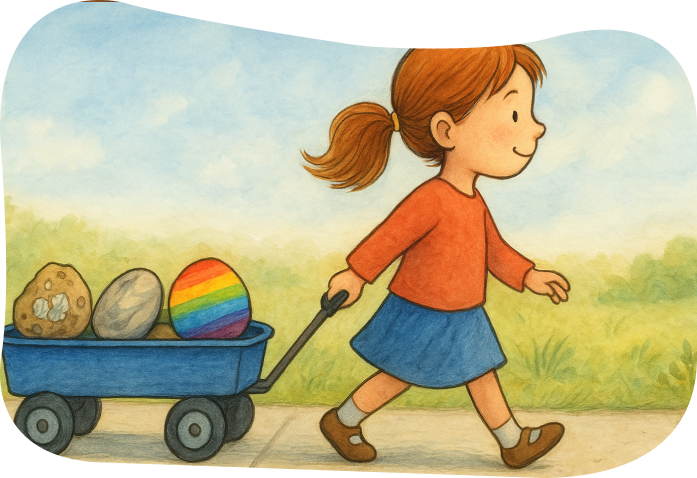
Every once in a while, a children’s book arrives that doesn’t just entertain it heals. Karen R. Sullivan’s The Blue Wagon is one of those rare stories. It begins with a child and a simple treasure hunt, but it grows into something much larger: a meditation on empathy, healing, and self-worth. Through Heather’s eyes, we are reminded that even the smallest discoveries can hold great meaning, and that kindness both given and received can make ordinary days into moments of connection.
Heather’s journey begins with excitement. She pulls her blue wagon along the sidewalk, eager to fill it with treasures. Each rock she collects has its own story. The first sparkles with crystals, the second is smooth and marbled, the third is painted in rainbow colors and gifted by Mr. Wiggledimp, and the fourth is rough, full of holes a rock she almost leaves behind. These objects are tangible, but their symbolism runs deep. They represent beauty, generosity, and the unseen value in what others overlook. When Heather learns that the hole-filled rock is actually a fossil, she is amazed. “Dinosaurs could have seen this rock?” she asks with wonder. That moment captures the spirit of curiosity she hopes to awaken in every reader the belief that there is wonder hidden in plain sight.
Yet as Heather’s wagon grows heavier, so too does the meaning. When she realizes she’s tired from pulling her treasures home, the story turns quietly profound. Her mother explains that heavy loads come in many forms not just rocks in a wagon, but thoughts and worries in our minds. “Sometimes grown-ups don’t pull wagons, but they pull thoughts out of their heads,” she says. In that tender moment, she bridges the emotional gap between childhood innocence and adult understanding. The lesson is universal: we all carry things we don’t have to carry alone.
This is what makes the book more than just a picture book it’s a story about emotional literacy. It teaches children to recognize when something feels heavy, to ask for help, and to value what truly matters. It also teaches adults to model vulnerability and empathy. Heather’s mother doesn’t hide her fatigue or her worry; instead, she turns it into a teachable moment. By doing so, she gives Heather the greatest treasure of all understanding.
Her writing journey mirrors this same healing arc. As she shared in her author reflection, writing the book was both a creative act and a personal one. Having grown up with her own childhood challenges, she found herself revisiting happy memories and realizing how far she had come. “I never thought I would write children’s books,” She said, “I thought I would write inner child books. And this in some way is an inner child book because it reaches all ages from 6 to 60.” That truth radiates through every page. The story comforts not only children but also the adults who read to them those still learning to forgive themselves, lighten their loads, and see beauty in imperfection.
The rainbow rock from Mr. Wiggledimp carries a special kind of symbolism. It represents connection across generations and the loneliness many elders feel when their stories are no longer valued. “My children don’t want this after I leave,” he says, offering Heather a chance to give the rock new life. In this exchange, she captures both the sorrow and grace of aging. The act of giving becomes an act of healing not only for the old man but for the reader, who witnesses love passed on in a simple, colorful stone.
By the story’s end, Heather learns to see her treasures differently. What began as a collection of pretty rocks becomes a reflection of life itself: some things are heavy, some are bright, and some carry history. When she and her mother walk hand in hand, Heather understands something that many adults take years to learn that empathy lightens every load.
The book is ultimately a story about hope the kind that grows quietly, like understanding between a parent and child. Its lesson is timeless: that what we value isn’t determined by others, but by the meaning we give it. As Mr. Wiggledimp tells Heather, “It doesn’t matter how important they are or how valuable they are to others; it only matters that they are valuable to you.” In that moment, Sullivan gives readers of all age permission to cherish their own treasures, however imperfect they may be.
In an era filled with noise, fear, and constant motion, the book offers something rare stillness. It reminds us that emotional growth begins with curiosity and that healing begins with being seen. For educators and parents, it’s a tool to start conversations about feelings, empathy, and resilience. For children, it’s a reassurance that their wonder is worth protecting. And for anyone who has ever felt the weight of their own “wagon,” it’s a gentle nudge to set it down once in a while, look around, and notice the quiet beauty of the world. She has given us more than a children’s story. She has given us a small, luminous mirror one that reflects not just childhood, but the best parts of humanity. The book is an illustrated book on empathy, healing, and hope. It’s a story that teaches us how to see not just the treasures in the world, but the ones we carry within ourselves.
Quick Links
Useful Links
Copyright © 2025 Karen Sullivan. All Rights Reserved.